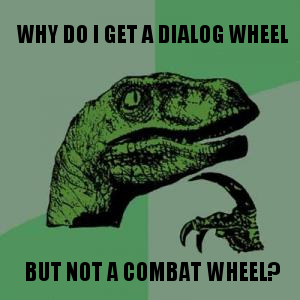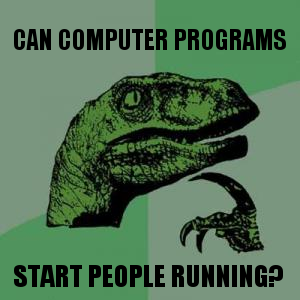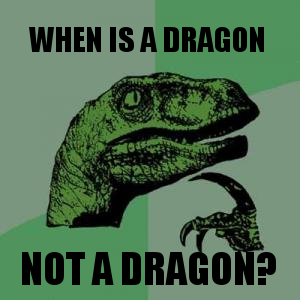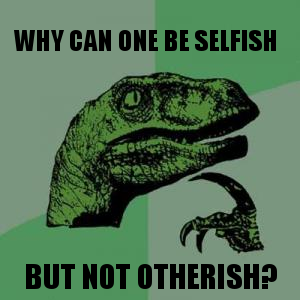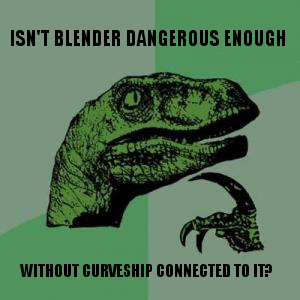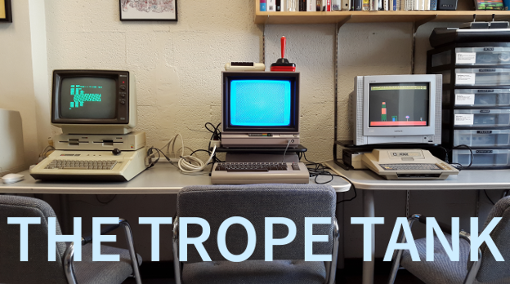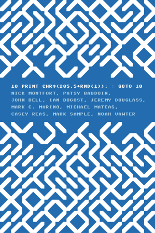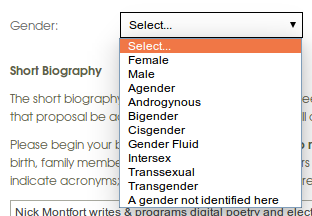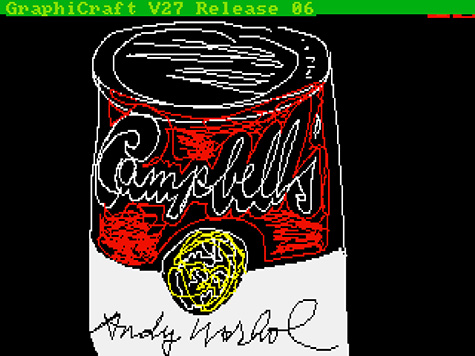(These pertain to Intelligent Narrative Technologies 7, and specifically today’s presentations. Perhaps, if you’re here, you will laugh. If you aren’t here, my regrets.)
Waves 3 Ways at @Party
codewiz and I (nom de nom) showed a wild demo at @party yesterday (June 14) at MIT.
It was “Waves 3 Ways (Topsy’s Revenge).” Indeed, there’s video.
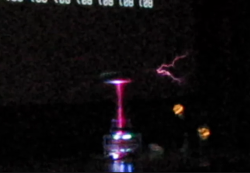 The concept is based on one-line C programs to generate music, the earliest of which were by viznut. I (nom de nom) wrote a C expression in this style to generate a waveform that could be output as sound but
The concept is based on one-line C programs to generate music, the earliest of which were by viznut. I (nom de nom) wrote a C expression in this style to generate a waveform that could be output as sound but
also consisted of all printable ASCII characters. The source is about 1kb, without much effort at compression. And the sound, in addition to driving speakers, can be (and was) connected to a Tesla coil.
To connect the oneTesla coil he built, codewiz modified the firmware and the control box to allow the audio output to be read by the potentiometer input. He also wrote dsptee.c to improve the way the text scrolls.
Topsy was the elephant electrocuted by Thomas Edison in 1903 to help prove that AC electricity (advocated by Tesla) was unsafe.
My main disappointment was that the projector, which I thought would be HD and thus the same as my display, showed only the left-hand side of the video. I should have checked it more thoroughly before we got started.
We were very pleased to get second place behind a nice oscilloscope demo.
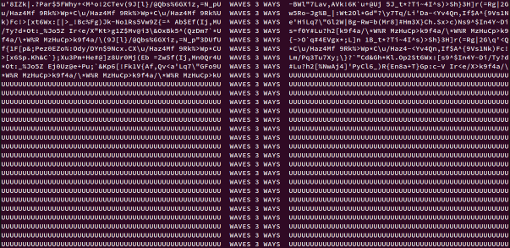
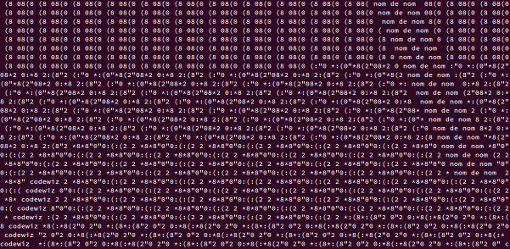
The final section of the demo is based on the bpNichol poem “Island,” part of his Apple IIe collection First Screening. This poem, in turn, refers to a concrete poem by Ian Hamilton Finlay. I’ve put a video/screencast of the end of the production online.
Trope Tank Annual Report 2013-2014
I direct a lab at MIT called The Trope Tank. This is a lab for research, teaching, and creative production, located in building 14 (where the Hayden Library is also housed), in room 14N-233. Its mission is to develop new poetic practices and new understandings of digital media by focusing on the material, formal, and historical aspects of computation and language.
The lab’s website has just been updated with some new information about our two major creative/research projects, Slant and Renderings. Earlier this academic year, a hardware and software catalog of Trope Tank resources was developed by Erik Stayton with contributions from Sylvia Tomayko-Peters.
As usual, the Trope Tanks hosts the monthly meetings of the local interactive fiction club, the People’s Republic of Interactive Fiction. Also, the Trope Tank’s series of digital writing presentations, Purple Blurb, continued this year; I was on leave in Fall 2013, but the series was back and hosted four excellent presentations in Spring 2014. See those sites for more information about PR-IF and Purple Blurb.
Here’s what we’ve been up to since our last annual report in May 2013:
New Works: Creative projects released.
- Nanowatt, single-loading (3.5 KB) demoscene production for the VIC-20. By Nick Montfort, Michael C. Martin, and Patsy Baudoin as Nom de Nom, McMartin, and Baud 1. Shown and awarded 2nd place on 30 November 2013 at Récursion, Montréal.
- World Clock, computer generated novel with source code by Nick Montfort. Published on the Web 30 November 2013, in print at the Harvard Book Store.
- Round, digital poem by Nick Montfort. Published on the Web 14 August 2013 by New Binary Press.
- Duels — Duets, digital poem. By Stephanie Strickland and Nick Montfort. Published on the Web 14 August 2013 by New Binary Press.
- The Deletionist, digital poetry system. By Nick Montfort, Amaranth Borsuk, and Jesper Juul. 2011–2013. Premiered at E-Poetry 2013 in London and published on the Web.
- Three Rails Live, an interactive video installation. By Rod Coover, Nick Montfort and Scott Rettberg. 2011–2013. Documentation published on the web in bleuOrange 7, 2013.
Trope Reports: We have issued two technical reports.
- TROPE-13-02 – Videogame Editions for Play and Study (Clara Fernández-Vara and Nick Montfort)
- TROPE-13-03 – No Code: Null Programs (Nick Montfort)
Exhibit & Museum Event:
- Second Fridays: How People Connect, Presentation of Commodore 64 BASIC programming, Piotr Marecki and Erik Stayton, and event at the MIT Museum, February 14, 2014
- Programs at an Exhibition, Nick Montfort & Páll Thayer, an exhibit at the Boston Cyberats Gallery, March 6-16, 2014
Presentations:
- Marecki, Piotr, “Sticker literature or augmented reality literature,” David Foster Wallace Conference, Department of English, Illinois State University, May 23, 2014
- Marecki, Piotr, “The Road to Assland and early Polish Text Adventure Games,” People’s Republic of Interactive Fiction, The Trope Tank, MIT, May 13, 2014
- Montfort, Nick, “Combinatory Media and Possibilities for Documentary,” OpenDoc Lab, MIT, May 8, 2014
- Marecki, Piotr, “Polish Literature in the Digital Age,” MIT Comparative Media Studies/Writing, May 7, 2014
- Marecki, Piotr, “Textual Caves: Expanding the Literary Writing Space,” Shapeshifters: Recycling and Literature, Department of Comparative Literature, Yale University, April 25-26 2014
- Montfort, Nick “Exploratory Programming,” first of four major topics for the online Critical Code Studies Working Group 2014, 23 February-23 March, 2014.
- Montfort, Nick, “Aesthetic Obfuscated Code,” Symposium on Obfusctation, New York University, 15 February 2014.
- Montfort, Nick, “Ten Cases of Computational Poetics,” UCLA, M/ELT, 17 January 2014.
- Montfort, Nick, “Computational Poetic Models,” University of Southern California, SCA Complex, 16 January 2014
- Marecki, Piotr, “Polish Literature in the Digital Age,” IAP talk, MIT, January 21, 2014.
- Montfort, Nick, “Computational Literary Models for Fun and Poetics,” Concordia University, Montréal, 10 January 2014.
- Montfort, Nick, “Scaling Up Literary Models with Curveship and Slant,” 8th Mexican International Colloquium on Computational Creativity, UNAM, Mexico City, 15 November 2013.
- Montfort, Nick, “Literary Models,” 8th Mexican International Colloquium on Computational Creativity, UAM Cuajimalpa, Mexico City, 14 November 2013.
- Montfort, Nick, “Electronic Literature and Other Forms of Popular Creative Computing.” Keynote address at Writing Literature, Reading Society, Municipal Public Library, Kraków, 29 October 2013.
- Montfort, Nick, “10 PRINT,” MIT CSAIL Programming Language & Software Engineering retreat, MIT Endicott House, 21 May 2013
- Montfort, Nick, “Hardware and Emulation to Access Creative Computing,” Preserving.exe Summit, Library of Congress, 20 May 2013
- Baudoin, Patsy and Nick Montfort, “10 PRINT,” Writing Across the Curriculum, MIT, 17 May 2013
Translations: Andrew Campana translated “The Two” by Nick Montfort into Japanese. Piotr Marecki translated Montfort’s “Lede,” “The Two,” and World Clock (via translation of the novel-generating program) into Polish, and, with Aleksandra Małecka, translated “Between Page and Screen” by Amaranth Borsuk and Brad Bouse into Polish. These will be placed online when revisions are complete.
Teaching:
- The Trope Tank hosted a visit by The Word Made Digital, 21W.764, during Spring 2014.
- “Exploratory Programming Workshop” by Nick Montfort, New York University, 14 February 2014.
- Commodore 64 BASIC Workshop by Nick Montfort, offered for MIT’s Independent Activities Period, 29 January 2014.
- “Workshop in Exploratory Programming” by Nick Montfort, UAM Cuajimalpa, Mexico City, two meetings on 11-12 November 2013.
Upcoming: In Milwaukee this month Trope Tank researchers will present at (int)7 (Intelligent Narrative Technologies 7) and the Electronic Literature Organization Conference. The presentation will be “Expressing the Narrator’s Expectations” by Montfort and Stayton at (int)7, and at ELO in the conference paper sessions “The Formation of the Field of Electronic Literature in Poland” by Marecki, “Computational Editions, Ports, and Remakes of ‘First Screening’ and ‘Karateka'” by Stayton and Montfort, and “New Novel Machines: Nanowatt and World Clock” by Montfort. The ELO Media Arts show will include “The Postulate to Hyperdescribe the World” by Marecki and Aleksandra Małecka and “Round” by Montfort. Andrew Campana’s work will be part of the Gallery of E-Lit 1st Encounters.
Many papers and even some books developed with Trope Tank support are forthcoming, but instead of trying to enumerate those, I’ll list them next year, when they have appeared.
There’s a party — Perverbs.
I persist in my quest to develop extremely simple, easily modifiable programs that produce compelling textual output.
My latest project is Modern Perverbs. In a world where nothing is as it seems … two phrases … combine … to make a perverb. That’s about all there is to it. If phrase N is picked from the first list, some phrase that isn’t number N will be picked from the second, to ensure maximum perverbiality. The first phrase also carries the punctuation mark that will be used at the very end. This one is a good bit simpler than even my very simple “exploded sentence” project, Lede.
(I learned of perverbs and their power, I should note, thanks to Selected Declarations of Dependence by Harry Mathews.)
In case, for some reason, you fear the legal repercussions of ripping off my HTML and JavaScript and editing it, Modern Perverbs is explicitly licensed as free software. Save the page on your desktop as plain HTML (not “complete”), open it in an editor, and have a field day.
Sounds, User-Input Phrases, and Monkeys in “Taroko Gorge”
Check out “Wandering through Taroko Gorge,” a participatory, audio-enabled remix.
As James T. Burling stated on the “projects” page of MAD THEORY:
>In this combination of presentation and poetry reading, I’ll present a remix of Nick Monfort’s javascript poetry generator, “Taroko Gorge.” My remix added a musical component using a computers oscilloscope function, and more importantly allows participant-observers to type in answers to prompts which are then added to the poem in real-time. The poem will be available throughout the day, gradually adding all inputs to its total sum. I’ll discuss the process of decoding html and javascript as a non-coder, describe some of my theories on participatory performance using computer interfaces, and raise questions about agency in performance and how a digital artifact can function as a poetic event.
Inform Re-ups
There’s a major new release of Inform 7, build 6L02, the first new release of the interactive fiction system in three years.
Jill Walker Rettberg, this Monday’s Purple Blurb
MIT, room 14E-310
Monday 5/5, 5:30pm
Free and open to the public, no reservation required
Jill Walker Rettberg
“Seeing Ourselves Through Technology: How We Use Selfies, Blogs and Wearable Devices to Understand Ourselves”
 This Monday (2014-05-05) the Purple Blurb series of Spring 2014 presentations will conclude with a talk by Jill Walker Rettberg on a pervasive but still not well-understood phenomenon, the types of digital writing, tracking, photography, and media production of other sorts that people do about themselves. Her examples will be drawn from her own work as well as from photobooths, older self-portraits, and entries from others’ diaries.
This Monday (2014-05-05) the Purple Blurb series of Spring 2014 presentations will conclude with a talk by Jill Walker Rettberg on a pervasive but still not well-understood phenomenon, the types of digital writing, tracking, photography, and media production of other sorts that people do about themselves. Her examples will be drawn from her own work as well as from photobooths, older self-portraits, and entries from others’ diaries.
Jill Walker Rettberg is Professor of Digital Culture at the University of Bergen in Norway. Her research centers on how we tell stories online, and she has published on electronic literature, digital art, blogging, games and selfies. She has written a research blog, jilltxt.net, since October 2000, and co-wrote the first academic paper on blogs in 2002. Her book _Blogging_ was published in a second edition in 2014. In 2008 she co-edited an anthology of scholarly articles on _World of Warcraft._ Jill is currently writing a book on technologically mediated self-representations, from blogs and selfies to automated diaries and visualisations of data from wearable devices.
More about Purple Blurb …
Slice of Trope
Slice of MIT, an MIT alumni publication, has an article on my work with poetry and computation. It’s by Kate Hoagland, was written for National Poetry Month, and is an excellent short discussion of several recent projects and some themes in my work and that of my lab, The Trope Tank.
Happy 50th to BASIC
Dartmouth is celebrating the 50th anniversary of BASIC tomorrow with several events, including the premiere of a documentary on BASIC that I hope to see soon. I teach two classes tomorrow; those and my other meetings will make it impossible for me to stop by, even though Dartmouth is not very far away.
There’s also a celebratory Time article about BASIC, one that is packed with nice photos, scans, and GIFs showing how programs were listed and how they ran. The GIFs include a sped-up one of 10 PRINT running in an emulator, and there’s a link to 10 PRINT CHR$ (205.5 + RND (1)); : GOTO 10, our book (by Nick Montfort, Patsy Baudoin, John Bell, Ian Bogost, Jeremy Douglass, Mark C. Marino, Michael Mateas, Casey Reas, Mark Sample, and Noah Vawter).
I do genuinely appreciate the link and the article overall – there’s excellent discussion of popular programming, recollections of personally writing BASIC, BASIC in books and magazines, and even David Brin’s 2006 Salon article – but it’s too bad our book is (twice) referred to as “a book of essays” when it is actually a single book-length academic study of the title program; quite in distinction to a book of essays, it was written by the ten of us in a single voice. The book, which among other things provides the major academic study of BASIC this century, is also available for free online and anyone can download/open it in seconds to check it out. And if such a glance entices a reader, he or she may, like the popular BASIC programmer of the late 1970s and 1980s, dive further in and learn about formal, material, cultural, historical, and other aspects of the title program, the Commodore 64, BASIC, and more.
Gender? I Hardly Know ‘er
The AWP (Association of Writers & Writing Programs) offers you eleven options on their Web form for indicating your gender. But these are listed in a drop-down box, so you can’t choose more than one.
To give a specific example, you can’t choose “male” and “cisgender.”
OPPRESSION!
Scott Rettberg in Purple Blurb this Monday
MIT, room 14E-310
Monday 4/28, 5:30pm
Free and open to the public, no reservation required
Scott Rettberg
 This Monday (2014-04-28) Purple Blurb is proud to host a screening and discussion of narrative video art work done in collaboration with Roderick Coover, including _The Last Volcano, Cats and Rats, Three Rails Live,_ and _Toxicity._ (The last two are combinatory pieces; _Three Rails Live_ is a collaboration between Coover, Rettberg, and Nick Montfort.) These pieces deal with personal and global catastrophes and are written across languages, with one of the voices in _Cats and Rats_ in (subtitled) Norwegian. They continue Rettberg’s work on novel-length electronic literature projects and his frequent collaboration with others.
This Monday (2014-04-28) Purple Blurb is proud to host a screening and discussion of narrative video art work done in collaboration with Roderick Coover, including _The Last Volcano, Cats and Rats, Three Rails Live,_ and _Toxicity._ (The last two are combinatory pieces; _Three Rails Live_ is a collaboration between Coover, Rettberg, and Nick Montfort.) These pieces deal with personal and global catastrophes and are written across languages, with one of the voices in _Cats and Rats_ in (subtitled) Norwegian. They continue Rettberg’s work on novel-length electronic literature projects and his frequent collaboration with others.
Scott Rettberg is Professor of Digital Culture in the department of Linguistic, Literary, and Aesthetic studies at the University of Bergen, Norway. Rettberg is the project leader of ELMCIP (Electronic Literature as a Model of Creativity and Innovation in Practice), a HERA-funded collaborative research project, and a founder of the Electronic Literature Organization. Rettberg is the author or coauthor of novel-length works of electronic literature, combinatory poetry, and films including _The Unknown, Kind of Blue, Implementation, Frequency, Three Rails Live,_ and _Toxicity._ His creative work has been exhibited online and at art venues including the Chemical Heritage Foundation Museum, Palazzo dell Arti Napoli, Beall Center, the Slought Foundation, and The Krannert Art Museum.
More about Purple Blurb …
ELO Awards: Call for Nominations
The Electronic Literature Organization is delighted to announce two awards to be given this summer; nominations are open now.
>The ELO is proud to announce the ”The N. Katherine Hayles Award for Criticism of
>Electronic Literature” and “The Robert Coover Award for a Work of Electronic
>Literature.” Below is information including guidelines for submissions for each.
>
>http://eliterature.org/2014/04/announcing-elo-prizes-for-best-literary-and-critical-works/
>
>“The N. Katherine Hayles Award for Criticism of Electronic Literature”
>
>“The N. Katherine Hayles Award for Criticism of Electronic Literature” is an
>award given for the best work of criticism, of any length, on the topic of
>electronic literature. Bestowed by the Electronic Literature Organization and
>funded through a generous donation from N. Katherine Hayles and others, this
>$1000 annual prize aims to recognize excellence in the field. The prize comes
>with a plaque showing the name of the winner and an acknowledgement of the
>achievement, and a one-year membership in the Electronic Literature Organization
>at the Associate Level.
>
>We invite critical works of any length. Submissions must follow these
>guidelines:
>
>1. This is an open submission. Self nominations and nominations are both
>welcome. Membership in the Electronic Literature Organization is not required.
>
>2. There is no cost involved in nominations. This is a free and open award aimed
>at rewarding excellence.
>
>3. ELO Board Members serving their term of office on the Board are ineligible
>for nomination for the award. Members of the Jury are also not allowed to be
>nominated for the award.
>
>4. Three finalists for the award will be selected by a jury of specialists in
>electronic literature; N. Katherine Hayles will choose the winner from among the
>finalists.
>
>5. Because of the nature of online publishing, it is not possible to conduct a
>blind review of the submissions; the jury will be responsible for fair
>assessment of the work.
>
>6. Those nominated may only have one work considered for the prize. In the event
>that several works are identified for a nominee, the nominee will choose the
>work that he or she wishes to be juried.
>
>7. All works must have already been published or made available to the public
>within 18 months, no earlier than December 2012.
>
>8. All print articles must be submitted in .pdf format. Books can be sent either
>in .pdf format or in print format. Online articles should be submitted as a link
>to an online site.
>
>9. Nominations by self or others must include a 250-word explanation of the
>work’s impact in the field. The winner selected for the prize must also include
>a professional bio and a headshot or avatar.
>
>10. All digital materials should be emailed to elo.hayles.award@gmail.com by May
>15, 2014; three copies of the book should be mailed to Dr. Dene Grigar, Creative
>Media & Digital Culture, Washington State University Vancouver, 14204 NE Salmon
>Creek Ave., Vancouver, WA 98686 by May 15, 2014. Those making the nomination or
>the nominees themselves are responsible for mailing materials for jurying. Print
>materials will be returned via a self-addressed mailer.
>
>11. Nominees and the winner retain all rights to their works. If copyright
>allows, ELO will be given permission to share the work or portions of it on the
>award webpage. Journals and presses that have published the winning work will be
>acknowledged on the award webpage.
>
>12. The winner is not expected to attend the ELO conference banquet. The award
>will be mailed to the winner.
>
>Timeline
>
>Call for Nominations: April 15-May 10
>
>Jury Deliberations: May 15-June 10
>
>Award Announcement: ELO Conference Banquet
>
>For more information, contact Dr. Dene Grigar, President, Electronic Literature
>Organization: “dgrigar” at mac.com.
>
>“The Robert Coover Award for a Work of Electronic Literature”
>
>“The Robert Coover Award for a Work of Electronic Literature” is an award given
>for the best work of electronic literature of any length or genre. Bestowed by
>the Electronic Literature Organization and funded through a generous donation
>from supporters and members of the ELO, this $1000 annual prize aims to
>recognize creative excellence. The prize comes with a plaque showing the name of
>the winner and an acknowledgement of the achievement, and a one-year membership
>in the Electronic Literature Organization at the Associate Level.
>
>We invite critical works of any length and genre. Submissions must follow these
>guidelines:
>
>1. This is an open submission. Self nominations and nominations are both
>welcome. Membership in the Electronic Literature Organization is not required.
>
>2. There is no cost involved in nominations. This is a free and open award aimed
>at rewarding excellence.
>
>3. ELO Board Members serving their term of office on the Board are ineligible
>for nomination for the award. Members of the Jury are also not allowed to be
>nominated for the award.
>
>4. Three finalists for the award will be selected by a jury of specialists in
>electronic literature; Robert Coover or a representative of his will choose the
>winner from among the finalists.
>
>5. Because of the nature of online publishing, it is not possible to conduct a
>blind review of the submissions; the jury will be responsible for fair
>assessment of the work.
>
>6. Those nominated may only have one work considered for the prize. In the event
>that several works are identified for a nominee, the nominee will choose the
>work that he or she wishes to be juried.
>
>7. All works must have already been published or made available to the public
>within 18 months, no earlier than December 2012.
>
>8. Works should be submitted either as a link to an online site or in the case
>of non-web work, available via Dropbox or sent as a CD/DVD or flash drive.
>
>9. Nominations by self or others must include a 250-word explanation of the
>work’s impact in the field. The winner selected for the prize must also include
>a professional bio and a headshot or avatar.
>
>10. Links to the digital materials or to Dropbox should be emailed to
>elo.coover.award@gmail.com by May 15, 2014; three copies of the CD/DVDs and
>flash drives should be mailed to Dr. Dene Grigar, Creative Media & Digital
>Culture, Washington State University Vancouver, 14204 NE Salmon Creek Ave.,
>Vancouver, WA 98686 by May 15, 2014. Those making the nomination or the nominees
>themselves are responsible for mailing materials for jurying. Physical materials
>will be returned via a self-addressed mailer.
>
>11. Nominees and the winner retain all rights to their works. If copyright
>allows, ELO will be given permission to share the work or portions of it on the
>award webpage. Journals and presses that have published the winning work will be
>acknowledged on the award webpage.
>
>12. The winner is not expected to attend the ELO conference banquet. The award
>will be mailed to the winner.
>
>Timeline
>
>Call for Nominations: April 19-May 10
>
>Jury Deliberations: May 15-June 10
>
>Award Announcement: ELO Conference Banquet
>
>For more information, contact Dr. Dene Grigar, President, Electronic Literature
>Organization: “dgrigar” at mac.com.
Bitcoin for your Warhol!
Thanks to Golan Levin’s “atypical, anti-disciplinary and inter-institutional” FRSCI lab, the CMU Computer Club, and ROM hacking bit-boy Cory Archangel, several instances of previously unknown visual artwork, done by Andy Warhol on the Amiga 1000 in 1985, have been recovered.
Warhol’s use of this classic multimedia system is but one of the many surprising, rich aspects of Amiga history that are carefully detailed by Jimmy Maher in The Future Was Here: The Commodore Amiga. An early topic is the launch of the first Amiga computer at the Lincoln Center, with Andy Warhol and Debbie Harry in attendance and with Warhol producing a portrait of her on the machine during the festivities. Maher also writes about how Warhol’s attitude toward the computer was actually a bit retrograde in some ways: Rather than thinking of the screen as a first-class medium for visual art, he wanted better printers that could produce work in a more conventional medium. The discussion of Warhol’s involvement is but one chapter (actually, less than one chapter) in a book that covers the Amiga’s hardware development, technical advances, relationship to image editing and video processing work, and lively demos — from the early, famous “Boing Ball” demo to the productions of the demoscene. The Future Was Here is the latest book in the Platform Studies series, which I edit with Ian Bogost.
With these images surfacing now, after almost 30 years, the age-old question “soup or art?” is awakened in us once again. Do we need to print these out to enjoy them? To sell them for cash? Did Warhol invent what is now thought of as the “MS Paint” style, back on the Amiga 1000 in 1985?
Note, finally, that there is a detailed report on the recovery project provided in PDF form.
A Superreboot
There’s a _remake_ (or maybe a _reboot_?) of superbad.com, the classic, off-kilter, uncanny art website that was employed back in 2008 in a Grand Text Auto April Fool’s joke.
It’s www.orworse.net.
I guess they made it worse by adding a “www.”
Console Yourself In Flight
If you, like Ian Bogost, manage to attain Titanium Medallion status on Delta, you too can influence the content of the company’s safety videos.
Transcendance
The premiere of the film Transcendance, directed by Wally Pfister and starring Johnny Depp as AI researcher Dr. Will Caster, was last night in Westwood. I got to go since my spouse produced and co-wrote the iOS and Android game that accompanies this movie. Johnny Depp and other cast members were there, but, alas, I did not get to hang with them; there were many interesting conversations nevertheless and I was glad to get to see the film for the first time. (Those involved with it had often seen very many cuts already, of course.) The general theatrical release of the film is April 18.
It’s an idea-packed film with a good bit of action, explosions, and so on, as well as innumerable nanites. Much can and will be said of it. One thing I was pleasantly surprised to note, though, was that the film expressed a bit how AI researchers (and by extension academic researchers more generally) have different motivations for what they do. Some are mainly interested in the challenges that problems present, because those problems are beautiful or inherently interesting. Some want to learn and understand things about the world. Some want to produce benefits in the world. And (although this group is not represented among the top researchers in the world) for some it’s just a job to make a living. It was nice to see the nuance of these different motivations in the way AI research was portrayed in Transcendance.
Microcodes and more Non-Object Art
In NOO ART, The Journal of Objectless Art, there’s a conversation between Páll Thayer and Daniel Temkin that was just posted. (Thayer recently collaborated with me to put up “Programs at an Exhibition,” the first software art show at the Boston Cyberarts Gallery.) The conversation covers Thayer’s code art, including his Perl Microcodes and antecedents, but also touches on free software, Windows, various esoteric languages by Temkin and others, painting and drawing, Christiane Paul’s CodeDOC project at the Whitney, “expert cultures,” and the future of code-based art.
It’s great reading, and objectless art might be just the thing to go with your object-oriented ontology.


